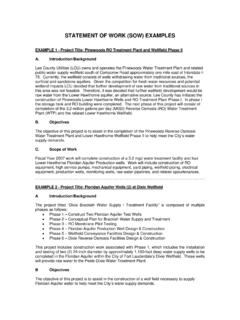Transcription of Vapor Retarder Classification - Energy
1 Since 2006 the IRC has permitted Class III Vapor retarders like latex paint (see list above) in all climate zones under certain conditions thanks to research by building America and well-insulated homes have little or no tolerance for drying if they get wet; moisture control is critical. That s why building America research establishing Vapor Retarder classifications and their appropriate applications has been instrumental in the market transformation to high-performance homes. As buildings have gotten tighter over the past several decades, questions about Vapor retarders and Vapor barriers have confounded builders and code developers. Vapor barriers have traditionally been installed on the warm in winter side of the wall assembly in an attempt to keep interior moisture from entering the wall cavity where it can condense on cold surfaces within the wall and lead to mold and rot.
2 However, determining the best location for the Vapor barrier is difficult in climates that are cold in winter, but hot enough in summer to use air conditioning. The Vapor barriers intended to keep moisture out in winter can also prevent the wall from drying out if condensation does form on the back side during America-sponsored research has been instrumental in clarifying the International Residential Code in regard to Vapor Retarder requirements. In an article published in the ASHRAE Journal August 2004, building Science Corporation s Joe Lstiburek noted the confusion in the building industry over terms such as Vapor retarders, Vapor barriers, Vapor permeable, and Vapor impermeable (Lstiburek 2004). Lstiburek proposed that Vapor control measures be defined more precisely, taking into account regional climatic influences and cladding type.
3 In the ASHRAE paper, Lstiburek provided a detailed proposal for building code requirements for Vapor retarders based on field and laboratory research. Lstiburek proposed that there should be three classes of Vapor retarders based on permeability as defined using the ASTM E-96 Test Method A (the desiccant method or dry cup method) and that a Vapor barrier should be defined as a Class I Vapor Retarder . At that time (2004) the International building Code (and its derivative codes) defined a Vapor Retarder as perm or less, equivalent to Lstiburek s definition of a Class II Vapor Retarder . In the paper, Lstiburek provided examples of 14 different wall assemblies designed with the minimum Vapor retarders proposed.
4 Each assembly was evaluated using dynamic hygrothermal modeling. The moisture content of the building materials that comprised the building assemblies all remained below the equilibrium moisture content of the materials as specified in ASHRAE proposed Standard 160P, Design Criteria for Moisture Control in Buildings (Lstiburek 2004). The Vapor Retarder Classification developed by building America research has been effectively integrated into the national model Energy code and now impacts 100,000s of new homes constructed each year so they more effectively control moisture flow and provide more durable AMERICA TOP INNOVATIONS HALL OF FAME PROFILEINNOVATIONS CATEGORY:4. Infrastructure Informing Codes and Standards ProcessVapor Retarder Classification Brick Air gap Rigid XPS Housewrap OSB Wood stud cavity with insulation Gypsum board Latex paintVAPOR PROFILE building TECHNOLOGIES PROGRAMR ecognizing Top Innovations in building Science The Department of Energy s building America program was started in 1995 to provide research and development to the residential new construction and remodeling industry.
5 As a national center for world-class research, building America funds integrated research in market-ready technology solutions through collaborative partnerships between building and remodeling industry leaders, nationally recognized building scientists, and the national laboratories. building America Top Innovation Awards recognize those projects that have had a profound or transforming impact on the new and retrofit housing industries on the road to high-performance INNOVATIONSBUILDING AMERICABUILDING AMERICA TOP INNOVATIONS HALL OF FAME PROFILE REFERENCESG atland, SD II. 2010. Vapor Retarders Play Crucial Role in building Envelope Moisture Management Strategies, Interface. April 2010, , JW. 2004. Understanding Vapor Barriers, ASHRAE Journal.
6 August 2004, Updated version April 2011, available at building Science Corporation, , and Lstiburek. 1998. Vented and Sealed Attics In Hot Climates. ASHRAE Transactions, 104(2), June 1998, , JF. 2001. The Influence of Low-Permeance Vapor Barriers on Roof and Wall Performance, Proceedings of Thermal Performance of building Envelopes, VII. Clearwater Beach, Florida, Dec 2-7, 2001. Retarder DefinitionsThe 2009 IRC gives the following definitions and examples for Vapor Retarder classes:ClassDefinitionExamplesI< permSheet polyethylene, sheet metal, non-perforated aluminum foil, foil-faced insulation sheathingII> to < permKraft-faced fiberglass batts or low-perm paint, unfaced expanded polystyrene, fiber-faced polyisocyanurateIII> permLatex or enamel paintBased on this and other field and laboratory research, Lstiburek proposed that no Vapor Retarder be required in IECC Climate Zones 1 through 3.
7 He indicated that a Class III Vapor Retarder was adequate in Climate Zones 4 and 5 under certain conditions. He recommended a Class II or I Vapor Retarder in Climates Zones 6 and 7 depending on conditions, as noted in the paper (Lstiburek 2004). As a result of the work by Lstiburek and other building scientists, the 2007 supplement to the 2006 IRC provided a new rating system for Vapor retarders based on their permeance (Gatland 2010). Based in part on building America research (see Rudd and Lstiburek 1998), the 2006 IECC and 2007 supplement to the IRC code exempted IECC Climate Zones 1 through 4 (including the hot-humid and mixed-humid climates) from the requirement to have a Class I or II Vapor Retarder in wall assemblies.
8 Even in Climate Zones 5 through 8, the IRC does not require a Class I or II Vapor Retarder , like polyethylene, but permits the use of a Class III Vapor Retarder , like latex paint, if the wall cavity has a vented cladding or rigid foam sheathing, as defined in the 2009 IRC Table and shown in the table III Vapor RetardersZoneClass III Vapor retarders permitted for:Marine 4 Vented cladding over OSB Vented cladding over plywood Vented cladding over fiberboard Vented cladding over gypsum Insulated sheathing with R-value over 2x4 wall Insulated sheathing with R-value over 2x6 wall5 Vented cladding over OSB Vented cladding over plywood Vented cladding over fiberboard Vented cladding over gypsum Insulated sheathing with R-value R-5 over 2x4 wall Insulated sheathing with R-value over 2x6 wall6 Vented cladding over fiberboard Vented cladding over gypsum Insulated sheathing with R-value over 2x4 wall Insulated sheathing with R-value over 2x6 wall7 & 8 Insulated sheathing with R-value R-10 over 2x4 wall Insulated sheathing
9 With R-value R-15 over 2x6 wallAccording to the 2009 IRC: For the purposes of this section vented cladding shall include the following minimum clear air spaces. Other openings with the equivalent vent area shall be permitted. 1. Vinyl lap or horizontal aluminum siding applied over a weather-resistive barrier as specified in Table of the 2009 International Residential Brick veneer with a clear airspace as specified in Section of the International Residential Other approved vented building Technologies Program America Solutions Center January 2013


















